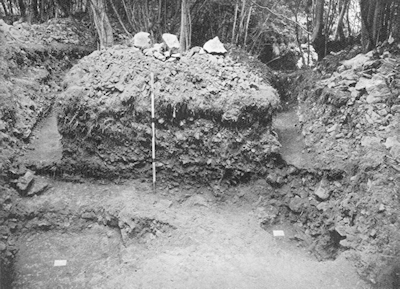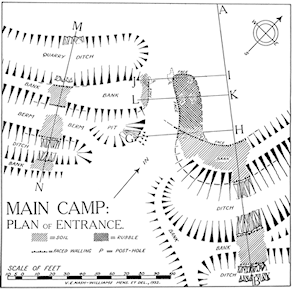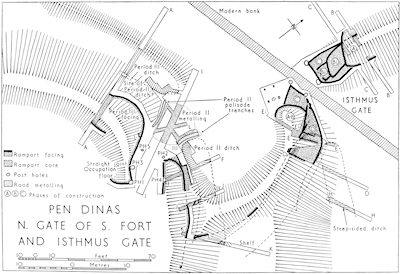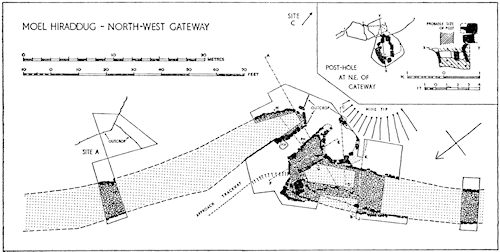



In common with many excavators of hillforts down the years, Nash-Williams was drawn to tackle an entrance of Llanmelin Camp, which suffered intensely at his hands, with transverse trenching followed by chasing of revetment walls in lateral extensions. Again, the limits of his exploration are difficult to determine, so that his summary plan emits a rather more authoritative air than appears to have been justified by the reality on the ground (Figure 9). Such coarse and partial treatment was not confined to the work at Llanmelin, as is readily illustrated by a second instance of published photograph and plan (Figure 10), showing entrances examined by a different excavator in the mid-1930s, at Pen Dinas, Aberystwyth, with a plethora of trenches and seeming to require as much skill in the art of burrowing as in any sensible archaeological technique (Forde et al. 1963; cf. Driver 2013, fig. 1.1 and, especially, p. 72, calling into question received interpretations of Pen Dinas, despite his optimistic fig. 5.3). Harking back to earlier examples, Hughes's terse explanation of his procedure at Tre'r Ceiri leaves little room for doubt that his was also a heavy-handed exercise — 'the two main entrances were cleared sufficiently to ascertain their plans' is all we are told of extent and method there (1907, 39, 57-9). So too at Pen y Corddyn, where photographs of the entrances under excavation allow us to appreciate how neat and simple drawings of plans and sections, as published by more than one authority at that time (Hughes 1906; Gardner 1910), have effectively sanitised what amounted to crude and partial clearance. The best that can be said is that their efforts did represent an improvement upon the vague 'end to end' trenching undertaken shortly beforehand by Baring-Gould and colleagues at St David's Head and at Moel Trigarn (as already explained). All told, such poor work needs to be explicitly exposed for its manifest fallibility.


An instructive comparison with Llanmelin, Pen Dinas, and their ilk may be drawn from an excavation at the opposite end of the 1930s spectrum of strategy and execution, for it is impossible to imagine how the unrefined work seen at any of the entrances remarked above could ever have come to terms with complexities of post-setting and sequence like those discovered by O'Neil in opening a consolidated block at the Southern Entrance of Ffridd Faldwyn (Figure 12; and see note 16 and section 2.6).15 That said, in 1933-5, O'Neil had himself indulged in partial emptying of an entrance passage at The Breiddin (1937, fig. 3, pls II-i and III-ii), examining patches of ground too tight to afford a reliable overall view of its structures, and this formed a major part of a project that must very soon have come to look dated following developments only a few years later at nearby Ffridd Faldwyn.16
All other things being equal, the less restricted is the stripping of any entrance, the more likely it is to provide a usable record. To take a simple example, had the North-West Gateway at Moel Hiraddug been exposed less extensively than it was by Houlder (1961, 12-16 — see combination of his photograph and plan reproduced in Figure 11 here), we might well have been left to wonder whether the meagre total of two postholes, each lacking a corresponding pair across the portal, was genuine. As it is, just about enough seems to have been done there to satisfy curiosity on that score (albeit interpretation of the recorded postholes remains difficult) and to allow the structural progression of this entrance to be outlined with tolerable confidence, giving scope both for interpretative adjustment and for correlation with the Main Inner Gateway of the same hillfort, as subsequently excavated by Davies (Brassil and Guilbert 1982, 84-5, fig. 29, noting the possibility of a third phase; cf. Avery 1993, 241-2; Davies and Lynch 2000, 153-4).17


The close similarity of principal structural elements and parallel sequence of development identifiable within the Main Inner Gateway (and so perhaps also in modified form in the North-West Gateway) of Moel Hiraddug and in the South-East Entrance of neighbouring Dinorben can be held to reinforce the case for wider excavation of hillfort entrances (Guilbert 1979b). Probably the best of Gardner's achievements at Dinorben came in adumbrating an essentially threefold sequence in that entrance, starting with relatively plain rampart-terminals, where gate(s) stood at or near the inner end of the gap, progressing to a more elaborate architecture, which incorporated guard-chambers recessed into expanded terminals set behind repositioned gate(s),18 and culminating in a lengthened passageway, all revetted in dry masonry (Gardner and Savory 1964, 17-29, fig. 5).19 His method of excavating this complex entrance was unsophisticated, apparently covering an adequate area less by initial intent than by accretion in response to a succession of clues (i.e. in essence, he kept following walls and extending excavation laterally until all had been exposed bit by bit), and his record of it may lack some detail (as observed above, any but the most substantial components are unlikely to feature in his plan and sections), but Gardner's persistence did pay off to the extent that he has supplied us with the bald outlines of a sequence supported by some excellent photographs of fine walling, in places standing remarkably high (especially Gardner and Savory 1964, pls VIIIa, IXb, Xa and XIa). This gives the lie to any impression imparted above that nothing worthwhile (bar also an informative haul of artefacts) came of his lengthy period of activity at Dinorben.
A feeling that structural modifications within entrances offer as good a barometer of chronological horizons as any aspect of hillforts has often been expressed in recent decades (e.g. Stanford 1971 (his first of several pertinent syntheses); Hogg 1975a, 66-73; Cunliffe 1991, 339-40). The problem is that too few entrances have yet been excavated competently for that potential to come anywhere near fulfilling the objective of extricating reliable sequences of well-defined forms of construction, thus perhaps to correlate with other hillforts near and, maybe even, far. This will require sensitive open-area excavation, so making it inevitable that many of those explored in the early days of hillfort archaeology can have little to contribute (by leave of Dinorben), simply because they are not dependable for anything like a full set of even the basic surviving structural information. It is arguable that no hillfort entrance has been excavated satisfactorily unless excavated in its entirety, and, again, this patently means that few have been tackled usefully in Wales.
Internet Archaeology is an open access journal based in the Department of Archaeology, University of York. Except where otherwise noted, content from this work may be used under the terms of the Creative Commons Attribution 3.0 (CC BY) Unported licence, which permits unrestricted use, distribution, and reproduction in any medium, provided that attribution to the author(s), the title of the work, the Internet Archaeology journal and the relevant URL/DOI are given.
Terms and Conditions | Legal Statements | Privacy Policy | Cookies Policy | Citing Internet Archaeology
Internet Archaeology content is preserved for the long term with the Archaeology Data Service. Help sustain and support open access publication by donating to our Open Access Archaeology Fund.